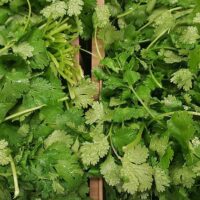An Herb that Helps Reduce Anxiety, Induce Sleep, and More
I find it fascinating when one single food, or in this case, an herb, can contribute so much to our health.
Cilantro is one such herb. While it’s not one of my favorites, I’m trying to creatively sneak it into my life because of its benefits.
By including fresh cilantro in your diet, you may benefit in the following ways:
- Rid the body of heavy metals such as arsenic, cadmium, aluminum, lead, and mercury. Cilantro has been shown to bind toxic metals together, loosening them from tissue and facilitating their elimination from the body.
- Protect against oxidative stress, in part due to the flavonoid quercetin. Oxidative stress is linked to diseases such as cancer, heart disease, Alzheimer’s, and more.
- Reduce anxiety and help improve sleep. Cilantro extract is a preferred option over drugs that may produce a variety of side effects.
- Prevent urinary tract infections due to antibacterial activity.

- Soothe skin irritations such as hives, poison ivy, and sunburns. To use externally, blend fresh cilantro with coconut oil and apply to affected area. For double benefits, blend cilantro with water (instead of coconut oil), strain, apply to skin, and drink remaining juice. This is especially helpful when you are experiencing an allergic reaction.
- Lower blood sugar.
- Improve heart health by lowering blood pressure and bad cholesterol.
- Aid digestion by helping produce digestive enzymes. Add chopped cilantro to spicy dishes to help prevent heartburn. Add to legumes and salads to reduce gas and bloating.
Coriander and cilantro are from the same plant. The term “cilantro” refers to the stalks and leaves, while “coriander” refers to dried cilantro seeds. Coriander is often used as a substitute for cumin, caraway seeds or fennel due to its similarities in taste.
Fresh cilantro is used to season soups, salsas, sauces, and chutneys. It brings a refreshing flavor and citrusy undertones to recipes. Add to dishes at the end of cooking to preserve nutrients and flavor.
Not a fan of cilantro? Turns out that there is a genetic variation that explains why some love it and others think it tastes like soap and can’t stand the smell of it.
I’ve been adding a handful of cilantro to my protein smoothies which sort of camouflages the taste.
Other ways to use cilantro:
- Add to sour cream or Greek yogurt before adding to soups, chili, stews, potatoes, dips.

- Toss with rice along with a twist of lime.
- Blend into your vinaigrette or citrus salad dressings.
- Add to your stir-fry at the end of cooking.
- Use it in your chutney.
- Stir into your salsa.
While no single food is THE superfood of superfoods, cilantro is another one for your health food toolbox.
Much love to you,
Health Coach Carol
“The real secret to guacamole is that you use exactly the elements that you need, which is cilantro, onion, tomato, and jalapenos. And, of course, avocado.”— Demian Bichir


